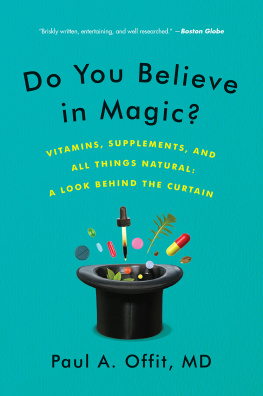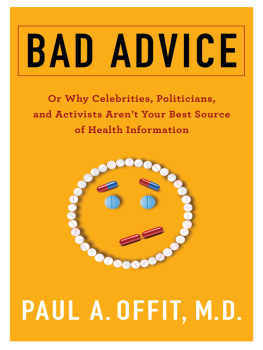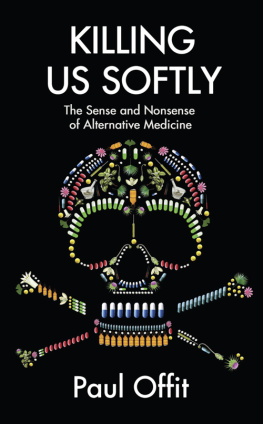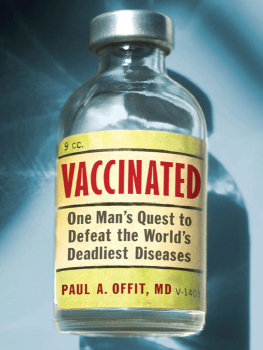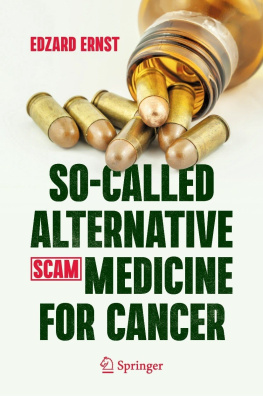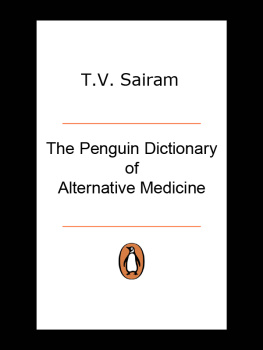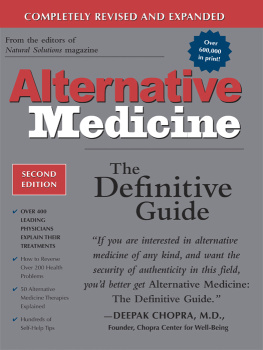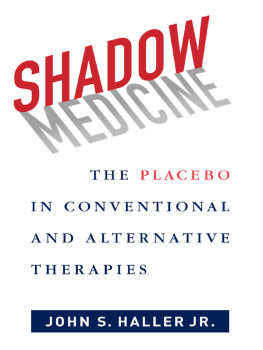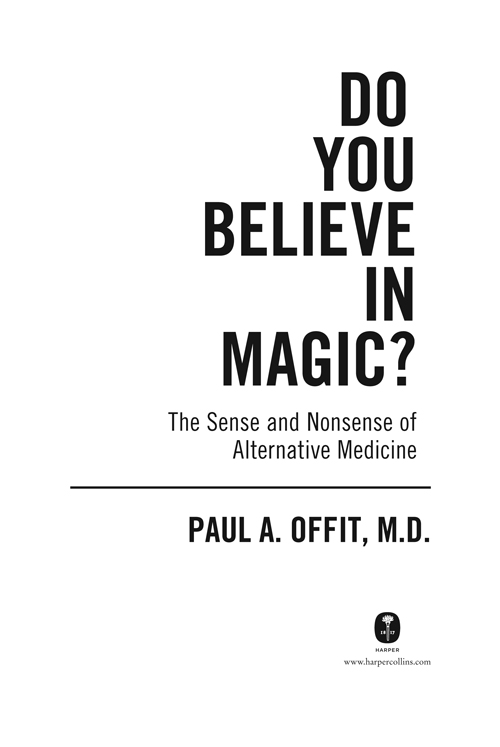
To all the science writers, science advocates, and science bloggers who have dared proclaim that the emperors of pseudoscience have no clothes
When religion was strong and science weak,
men mistook magic for medicine.
Now, when science is strong and religion weak,
men mistake medicine for magic.
THOMAS SZASZ
Contents
A mericans love alternative medicine. They go to their acupuncturist or chiropractor or naturopath to relieve pain. They take ginkgo for memory or homeopathic remedies for the flu or megavitamins for energy or Chinese herbs for potency or Indian spices to boost their immune systems. Fifty percent of Americans use some form of alternative medicine; 10 percent use it on their children. Its a $34-billion-a-year business. My friends are no different. One uses cold laser therapy for his allergies, another takes a homeopathic remedy named oscillococcinum to cure her colds, and a third swears that acupuncture is the only thing that relieves his back pain.
Furthermore, alternative medicinewhich in the 1960s was denigrated as fringe or unconventional medicinehas entered the mainstream. Hospitals have dietary supplements on their formularies or offer Reiki masters to cancer patients or teach medical students how to manipulate healing energies. In 2010, a survey of six thousand hospitals found that 42 percent offered some form of alternative therapies. When asked why, almost all responded, patient demand. Big Pharma is also jumping in. On February 27, 2012, Pfizer acquired Alacer Corporation, one of the countrys largest manufacturers of megavitamins.
The reason alternative therapies are popular is simple. Mainstream doctors are perceived as uncaring and dictatorial, offering unnatural remedies with intolerable side effects. Alternative healers, on the other hand, provide natural remedies instead of artificial ones, comfort instead of distance, and individual attention instead of take-a-number-and-wait-your-turn inattention.
L ike many people who have spent time in todays health-care system, my experiences have been largely disappointing.
I was born with clubfeet. Within hours, both feet were put in casts; the left foot healed; the right didnt. When I was five years old, a surgical procedure was performed on my right foot; one of the first of its kind, my case was later written up in a medical journal. The good news is that my right foot no longer turns awkwardly down and inward. The bad news is that walking is always somewhat painful for me.
While in medical school, I volunteered for a twenty-five-mile walkathon for the National Multiple Sclerosis Society. After completing the walk, the pain in my foot was so bad I had to use crutches for a few days. I visited an orthopedist, who told me I had severe osteoarthritis and that my X-ray looked like that of a seventy-year-old man. I was twenty-four. For most of my adult life, Ive tried conventional nonnarcotic pain medicines without relief.
When I was in my thirties, I noticed a small dark spotno bigger than the head of a pinon the front of my nose. I ignored it. Twelve years later, my wife suggested I have it removed. The procedure was fast and painless. But a few days later, the dermatologist called with some bad news. He had received a report from the pathologist. The diagnosis: metastatic malignant melanoma. A death sentence.
I panicked and immediately called the pathologist. This diagnosis doesnt make any sense, I pleaded. How could I have a metastatic lesion on only one part of my body that has remained unchanged for more than a decade? And wheres the primary cancer, the place from which the metastasis had supposedly spread? Doesnt this make me the longest-living survivor of untreated metastatic melanoma in history?! The pathologist was sympathetic but unfazed. The diagnosis was what it was. If I wanted her to, however, she was willing to send my biopsy to the nations foremost expert on melanoma: a dermatopathologist in New York City. A few weeks later, he called with his diagnosis: metastatic malignant melanoma. He patiently explained that, given where the malignant cells were and what they looked like, it couldnt be anything else.
For the next two years, I went to the dermatology clinic at the University of Pennsylvania, getting periodic physical examinations, chest X-rays, and blood tests looking for evidence of further metastases. None were found. Also, no one could find the original site from which my melanoma had supposedly spread. A mystery, they claimed.
Later, my wife, who is also a doctor, sent my biopsy to a dermatologist friend of hers, who said that I didnt have malignant melanomamy real diagnosis was cutaneous blue nevus syndrome, a benign disorder that mimics melanoma. I was happy to be done with it. But two years of thinking that I was suffering from a fatal illness had been hell.
When I was in my early fifties, a sharp, persistent pain in my left knee made it difficult to walk. Unable to tolerate it any longer, I visited an orthopedist, who diagnosed a partially torn medial meniscus (the cartilage in the knee that keeps bone from rubbing against bone). The surgery will be simple, he explained, with a full recovery in a few days. But in the postoperative haze of anesthesia, I learned that it hadnt been that easy. The orthopedist explained that my problem wasnt a torn meniscus after all; it was a loss of cartilage behind my kneecap. Instead of minor knee surgery, I had just undergone microfracture surgery, where small holes are drilled into bone. The recovery wasnt going to be a few daysit was going to be a year. The miscalculation didnt seem to surprise or upset the orthopedist. But it upset me.
By my mid-fifties, consistent with my age, I began to suffer symptoms of an enlarged prostate. Now I was in the world of urologists, which meant I would periodically get my PSA level checked. PSA, or prostate-specific antigen, is supposedly a predictor of prostate cancer. But the more I read studies about PSA, the more I realized it isnt a very good predictor at all. Even biopsies of the prostate are confusing. As it turns out, most men with prostate cancer die with the cancer, not from it. Which means that most men with prostate cancer have needless surgery. And the surgery is brutal, leaving many incontinent and impotent. As a consequence, urologists have varying opinions about how to avoid prostate cancer.
During these misadventures, Ive gotten a lot of advice from a lot of people. Some have gone as far as to suggest I abandon conventional medicine. They said I should take saw palmetto for my prostate and chondroitin sulfate and glucosamine for my foot and knee painall readily available without a prescription. They told me that I shouldnt have seen an orthopedistI should have seen an acupuncturist or a chiropractorand that I shouldnt have gone to a urologist for prescription drugs: I should have gone to a naturopath for something more organic, more natural. They urged me to stop being so trusting of modern medicine and to once and for all take control of my healthto leave a system that was clearly flawed.
So I went to the General Nutrition Center and bought saw palmetto, chondroitin sulfate, and glucosamine. But before I took them, I looked to see whether studies had been done showing they worked. The studies were large, internally consistent, well controlled, and rigorously performed. And the results were clear: saw palmetto didnt shrink prostates, and chondroitin sulfate and glucosamine didnt treat joint pain. Then I reviewed studies of acupuncture, naturopathy, homeopathy, and megavitamins, which also showed results far less amazing than my friends had led me to expect. Some therapies worked; most didnt. And for those that did work, it was how they worked that was surprising.

